SHARE
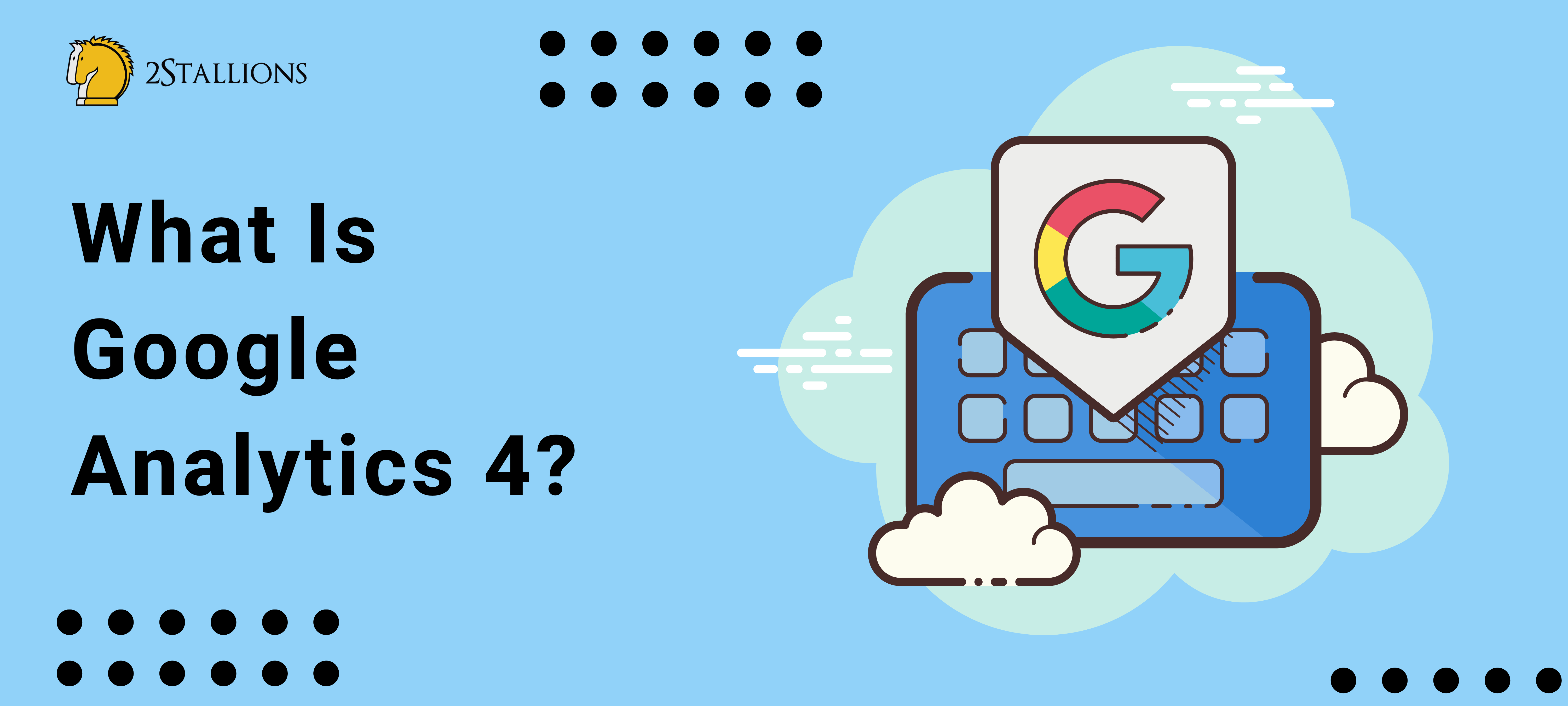
Google Analytics 4, commonly known as GA4, is the latest version of Google’s analytics platform. It is a powerful tool for website and app owners, marketers, and analysts to track and analyse user behaviour, engagement, and conversion metrics. GA4 is designed to provide a more comprehensive and user-centric approach to analytics than its predecessor, Universal Analytics.
Key Features and Aspects of Google Analytics 4
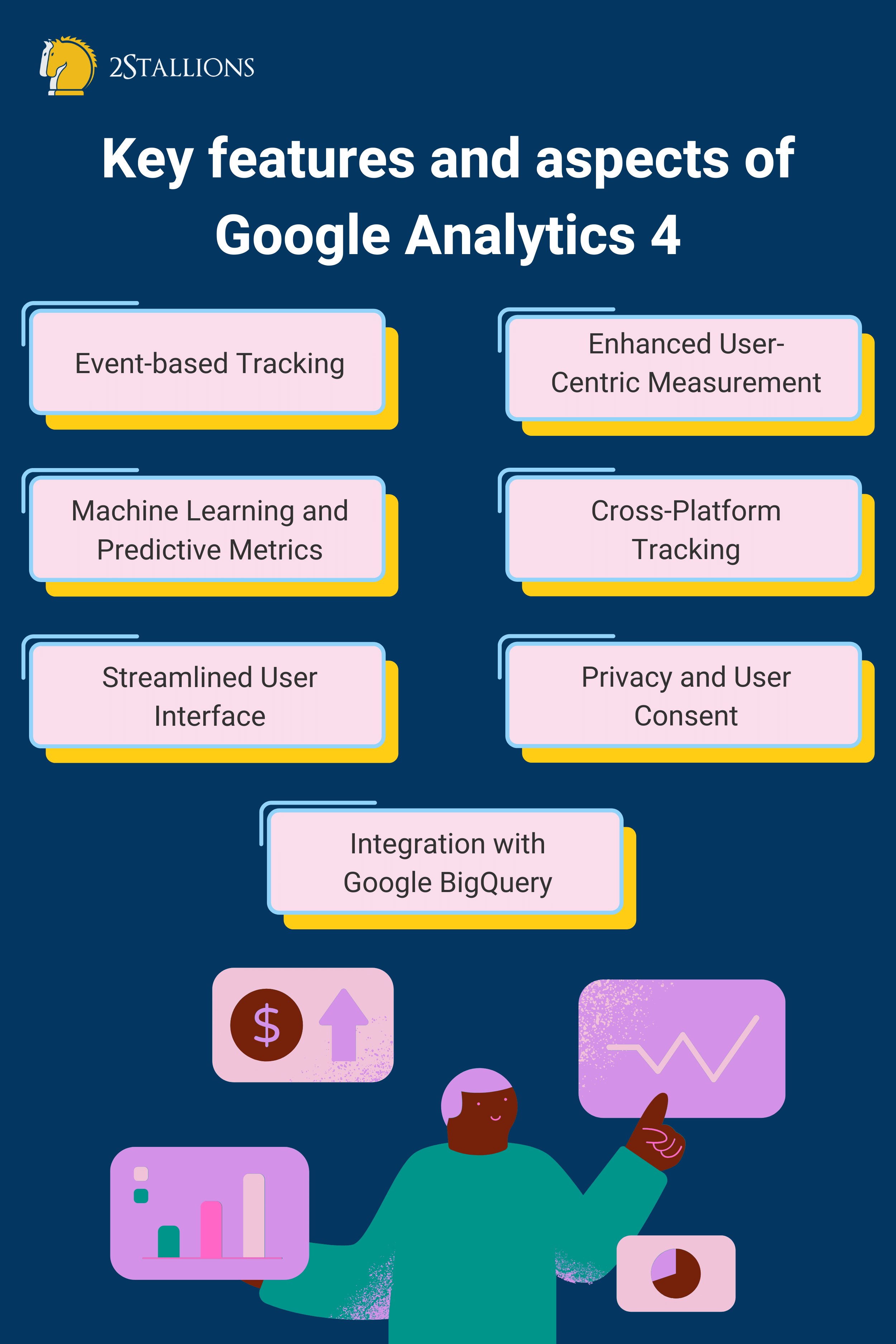
Event-based Tracking
GA4 shifts from the traditional pageview-centric model to an event-based tracking system. User interactions, such as clicks, video views, and form submissions, are treated as events. This approach allows for more flexibility in tracking specific user actions and understanding user engagement at a granular level.
[thrive_leads id=’8302′]
Enhanced User-Centric Measurement
GA4 emphasises user-centric measurement, focusing on user journeys across platforms and devices. It introduces the concept of a “user ID” to track users across sessions and devices, providing a more holistic view of user interactions.
Machine Learning and Predictive Metrics
Google Analytics 4 incorporates machine learning and artificial intelligence to provide more accurate predictions and insights. This includes predictive metrics such as churn probability, which helps businesses identify users at risk of leaving and take proactive measures to retain them.
Cross-Platform Tracking
With the increasing prevalence of multi-device and multi-platform usage, GA4 is designed to track user interactions across websites and mobile apps seamlessly. This allows for a unified view of user behaviour and engagement, regardless of their platform.
Streamlined User Interface
GA4 features a redesigned and more intuitive user interface, making navigating and accessing the necessary information easier. The reporting interface is organised into customisable dashboards, and users can create and share custom reports to suit their specific analytics needs.
Privacy and User Consent
GA4 strongly emphasises user privacy and data retention policies in response to evolving privacy concerns and regulations. It supports the measurement of conversions without relying on third-party cookies. It allows users to control data retention settings more effectively.
Integration with Google BigQuery
GA4 offers better integration with Google BigQuery, allowing users to export their raw, unsampled data for further analysis. This facilitates more in-depth analysis and custom reporting for businesses with advanced analytics needs.
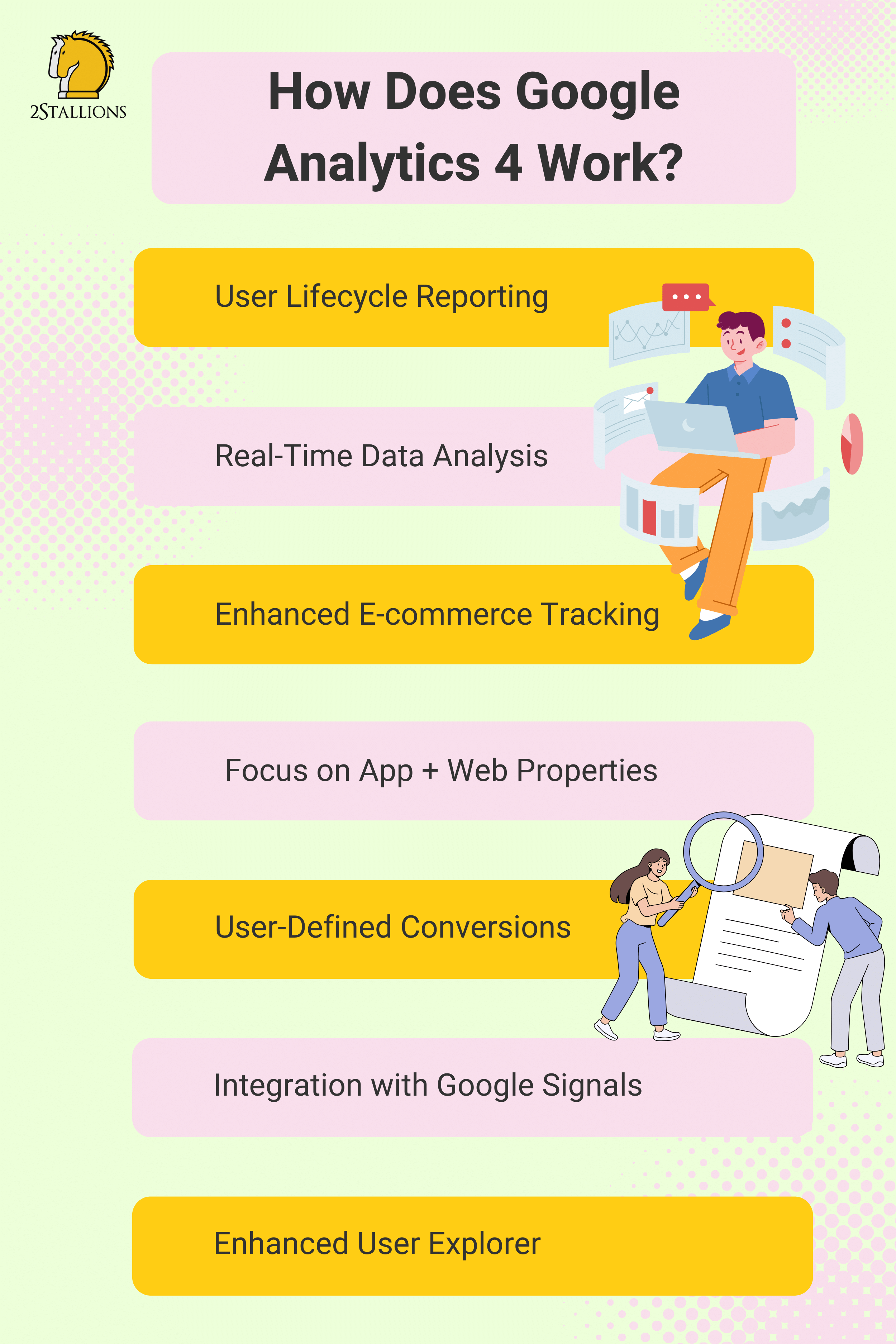
How Does Google Analytics 4 Work
Google Analytics 4 (GA4) employs a data collection, processing, and reporting system to give website and app owners insights into user behaviour and interactions. Here’s an overview of how GA4 works:
User Lifecycle Reporting
GA4 introduces a focus on the user lifecycle, allowing businesses to understand a user’s entire journey—from acquisition to conversion and retention. This provides insights into how users engage with a website or app over time.
Real-Time Data Analysis
GA4 emphasises real-time data analysis, allowing users to access up-to-the-minute insights into user interactions. This is particularly useful for monitoring live events, campaigns, or sudden changes in user behaviour.
Enhanced E-commerce Tracking
For businesses engaged in e-commerce, GA4 offers enhanced e-commerce tracking capabilities. It provides more flexibility in tracking and analysing transaction-related events, allowing companies to gain deeper insights into user purchasing behaviour.
Focus on App + Web Properties
GA4 is designed to seamlessly handle traditional websites and mobile apps within a single property. This allows businesses with a presence across multiple digital platforms to consolidate their analytics efforts.
User-Defined Conversions
In GA4, users can define and track custom conversions based on their business goals. This empowers businesses to measure and optimise towards the most critical outcomes.
Integration with Google Signals
GA4 integrates with Google Signals, allowing businesses to leverage additional insights from signed-in Google users. This includes information from Google services like Search, Maps, and YouTube, providing a more comprehensive understanding of user behaviour.
Enhanced User Explorer
The User Explorer feature in GA4 is improved, offering more detailed insights into individual user journeys. Users can explore the interactions of specific users over time, helping businesses understand the nuances of user engagement.
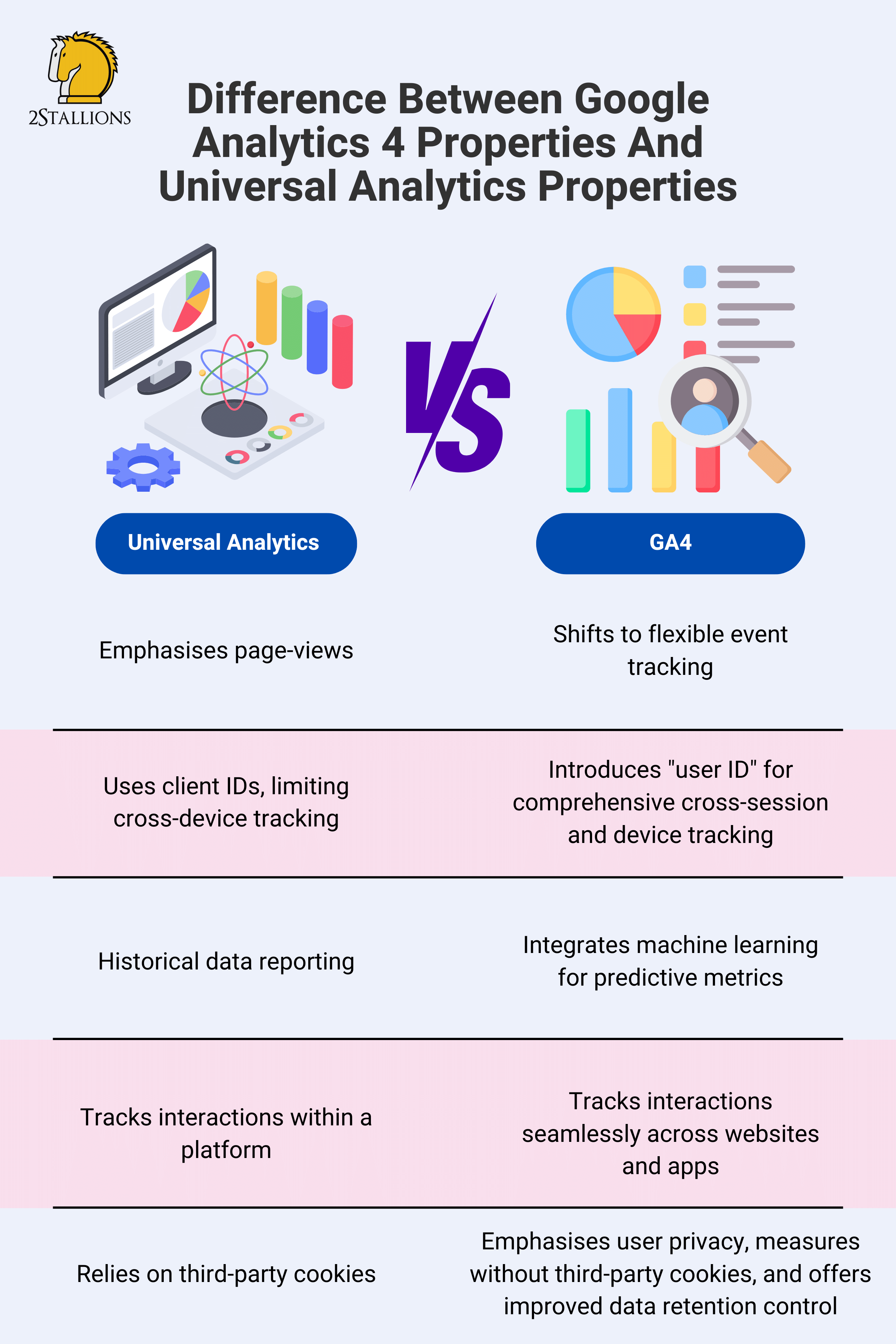
The Differences Between Google Analytics 4 and Universal Analytics
The key difference between Google Analytics 4 (GA4) and Universal Analytics properties lies in their approach to data collection, user-centric measurement, and the emphasis on events. Here are some notable distinctions:
Event-Based Tracking vs. Pageview-Centric Model:
- Universal Analytics: Primarily relies on a pageview-centric model. It significantly emphasises tracking pageviews, and events are often considered secondary.
- GA4: Shifts to an event-based tracking system, treating user interactions, such as clicks, video views, and form submissions, as events. This provides more flexibility to track specific user actions beyond traditional pageviews.
Example: In Universal Analytics, a user visiting a webpage may generate a pageview. Additional interactions, like clicking on a button, may be tracked as events. In GA4, pageviews and button clicks are treated as events from the outset.
User-Centric Measurement with the User ID:
- Universal Analytics: Typically relies on client IDs for user tracking, but the user journey across different devices and sessions might be challenging to connect.
- GA4: Introduces the concept of a “user ID” to track individual users across sessions and devices, offering a more holistic view of the user journey.
Example: If a user starts a session on a mobile device and later continues on a desktop, GA4 can connect these sessions using the user ID, more accurately representing the user’s engagement.
Machine Learning and Predictive Metrics:
- Universal Analytics: Primarily focuses on reporting historical data and does not incorporate advanced machine learning capabilities.
- GA4: Integrates machine learning to provide predictive metrics such as churn probability, helping businesses identify users at risk of leaving.
Example: GA4 can predict the likelihood that a user will churn based on their historical behaviour, allowing businesses to implement retention strategies proactively.
Cross-Platform Tracking:
- Universal Analytics: This can track user interactions within a specific platform (e.g. website). However, connecting user activity across platforms may require additional configurations.
- GA4: Designed to seamlessly track user interactions across websites and mobile apps, offering a unified view of user engagement.
Example: A user interacting with a website and a mobile app will have their activities consolidated in GA4, providing a more comprehensive understanding of their behaviour.
Privacy and Data Retention:
- Universal Analytics: Relies on third-party cookies for tracking, which may be affected by privacy concerns and regulations.
- GA4: Focuses on user privacy, supports measurement without third-party cookies, and provides more control over data retention settings.
Example: GA4 allows businesses to adapt to evolving privacy regulations by providing options to measure user interactions without relying on cookies.
Google Analytics 4 represents a significant evolution from Universal Analytics, offering a more flexible and user-centric approach to analytics. The shift to event-based tracking, emphasis on user IDs, integration of machine learning, and improved cross-platform tracking make GA4 a more powerful tool for understanding user behaviour in the modern digital landscape. Businesses transitioning to GA4 can benefit from a more comprehensive and detailed analysis of user interactions across various channels.
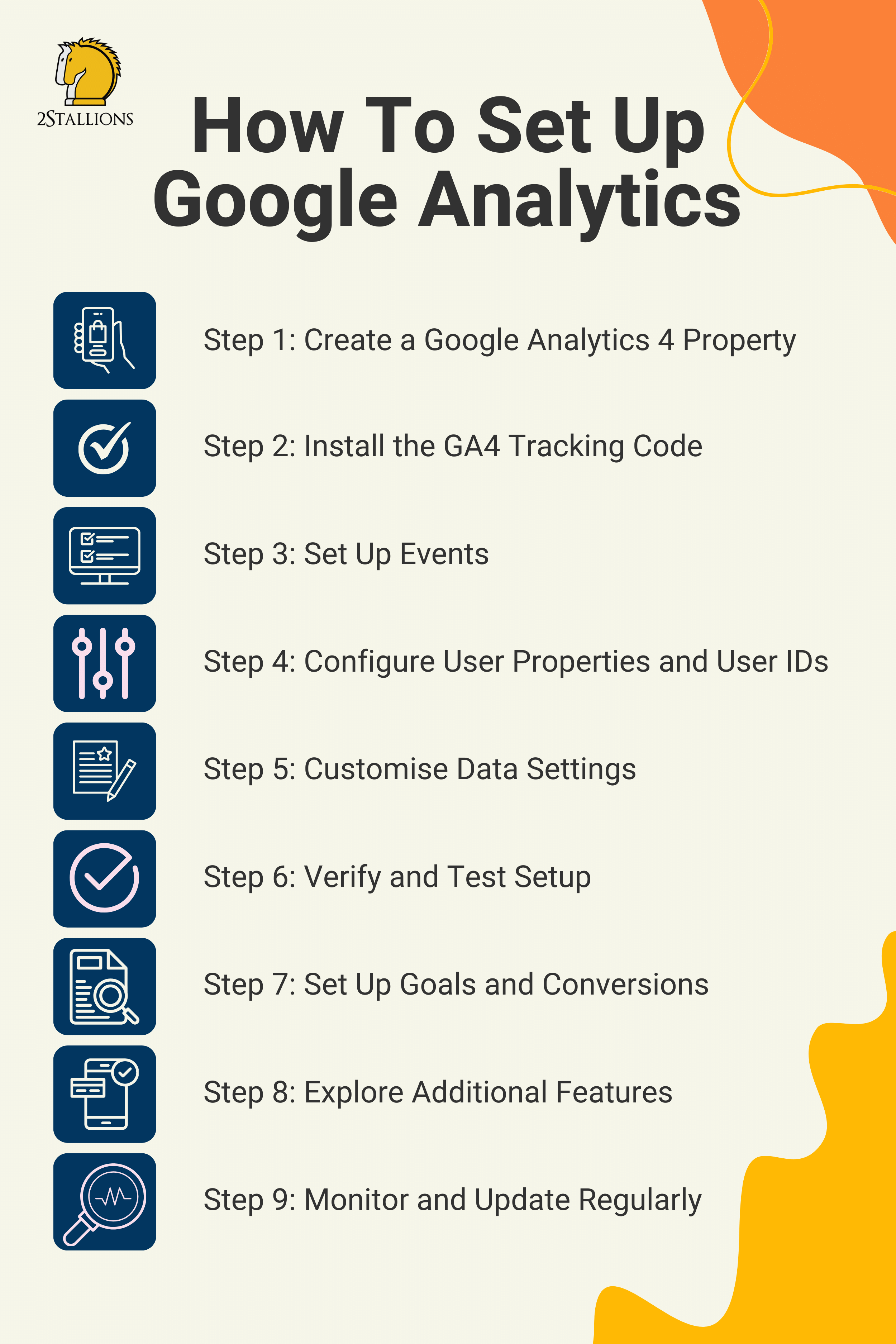
How To Set Up Google Analytics 4
Setting up Google Analytics 4 involves ensuring accurate data tracking and reporting. Here are steps on how to set up GA4:
Step 1: Create a Google Analytics 4 Property
- Go to the Google Analytics website and log in with your Google account.
- Click on the “Admin” section in the lower-left corner.
- Under the “Property” column, click the dropdown and select “Create Property.”
- Choose between “Web” or “App” as the platform type and fill in the required information for your property.
Step 2: Install the GA4 Tracking Code
- Once the property is created, you’ll receive a GA4 tracking code.
- For websites, add the tracking code to every page on your site, typically within the <head> section of your HTML. If you’re using a content management system (CMS), there may be a dedicated section for adding scripts.
- For mobile apps, integrate the GA4 SDK into your app code.
Step 3: Set Up Events
- Identify the fundamental user interactions you want to track as events (e.g., clicks, form submissions, video views).
- Implement event tracking in your website or app code using the tag function or the GA4 SDK for apps.
- Events in GA4 can be categorised, labelled, and structured to align with your specific tracking needs.
Step 4: Configure User Properties and User IDs
- Set up user properties to capture additional user information (e.g., user type, subscription status).
- If applicable, implement the user ID feature to track users across sessions and devices. This is particularly useful for understanding the user journey comprehensively.
Step 5: Customise Data Settings
- Adjust data settings according to your preferences. This includes options such as data retention periods and controlling personalised advertising features.
- Configure data streams for websites and apps to define specific data sources and properties.
Step 6: Verify and Test Setup
- After implementing the tracking code and configurations, verify the data collection by checking the real-time reports in GA4.
- Test the tracking of critical events to ensure that they are recorded accurately.
Step 7: Set Up Goals and Conversions
- Define goals and conversions that align with your business objectives. This could include completing a purchase, filling out a form, or spending a certain amount of time on a page.
- Use these goals to measure the success of your website or app in achieving specific outcomes.
Step 8: Explore Additional Features
- Familiarise yourself with GA4’s advanced features, such as machine learning insights, audience creation, and integration with Google BigQuery for more in-depth analysis.
- Utilise customisable dashboards and reports to monitor and analyse user behaviour.
Step 9: Monitor and Update Regularly
- Regularly check the GA4 reports to monitor user engagement, traffic sources, and other vital metrics.
- Update configurations as needed, significantly when changing your website or app structure.
Following these steps, you can set up Google Analytics 4 for your website or app and gain valuable insights into user behaviour and interactions. Remember that ongoing monitoring and adjustments are essential to ensure the accuracy and relevance of your analytics data.
Elevate your digital presence with a trusted SEM company! Enjoy impactful outcomes through our proven data-based search engine marketing strategy. Collaborate today for a digital transformation.
Originally published: 5 November 2020
Updated: 1 December 2023
Frequently Asked Questions about Google Analytics 4
What is the Difference Between Google Analytics and GA4?
Google Analytics (GA) and GA4 are both analytics platforms developed by Google. Still, they differ in their approach to data collection and analysis.
- Google Analytics (Universal Analytics): This is the older version of Google Analytics that follows a pageview-centric model. It primarily tracks pageviews and allows for customisation through events and goals.
- Google Analytics 4 (GA4): GA4, the latest version, introduces an event-based tracking system that focuses on user interactions rather than just pageviews. It emphasises user-centric measurement using a user ID and incorporates machine learning for predictive metrics.
What is Google Analytics Used For?
Google Analytics is a web analytics service provided by Google that allows website and app owners to track and analyse user behaviour. Its primary purposes include:
- Audience Insights: Understand who your users are, their demographics, and interests.
- User Behaviour Analysis: Track how users interact with your website or app, including pageviews, clicks, and other events.
- Conversion Tracking: Measure the success of specific goals and actions, such as form submissions or product purchases.
- Traffic Sources: Identify where your visitors come from, whether through search engines, social media, or other channels.
- Custom Reporting: Generate customised reports and dashboards based on your specific analytics needs.
What is the Difference Between Google Analytics 3 and 4?
- Tracking Model: GA3 follows a pageview-centric tracking model, while GA4 shifts to an event-based tracking system, treating user interactions as events.
- User-Centric Measurement: GA4 introduces the concept of a user ID for more effective tracking across sessions and devices.
- Machine Learning: GA4 incorporates machine learning for predictive metrics, providing insights such as churn probability.
- Cross-Platform Tracking: GA4 is designed to track user interactions across websites and mobile apps seamlessly.
- Privacy and Data Retention: GA4 strongly emphasises user privacy and allows more control over data retention settings.
How do I know if I am using Google Analytics 4?
To determine if you are using Google Analytics 4:
- Log in to your Google Analytics account.
- In the left navigation, go to the “Admin” section.
- Under the “Property” column, check if you see a property listed as “GA4 properties” or a specific GA4 property you created.










